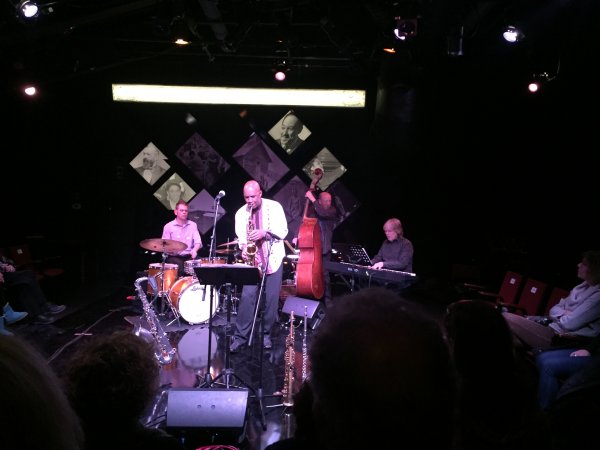Al M. and I attended a live jazz quartet last night. We heard the Stan Strickland Band. They played in a small black box theater. The performance was great but we were ultimately disappointed by the event. The singer/horn player, keyboardist and acoustic bassist were all amplified. The feed came out of two tiny monitors hidden amongst the theater lights in the blacked out ceiling. The voice and bass sounded strange. The sax sounded its best when Strickland walked away from the mic and into the center of the stage. Dynamics were constrained and I think this was from the timing and sound coming from two sources: the actual instrument and the monitors.
The experience reinforced for me the importance or influence that visual cues have. When I listened with my eyes open I had the perception that the sound was coming from the guy twenty feet in front of me who was moving his mouth. But when I closed my eyes, I could hear that the sound was clearly coming from the ceiling. Same with the bass. The drums were played mostly softly and were not amplified. They sounded great. When Al took out his digital SPL meter and it recorded 103 db during vocal peaks, we each put foam ear plugs in our ears. That, of course, made the sound even worse.
It was a fun evening, and the performance was great, but the sonics were disappointing. At least we left without our ears ringing. This event stands in stark contrast to the last live performance Al and I attended with MadFloyd. That was of a violinist and cellist playing in a private house in Boston for about twenty five people. No amplification needed and the shear energy of those two instruments filled the room with glorious sound. The music was intoxicating. It was much better than anything I've heard from an audio system. The amplified jazz quartet, on the other hand, sounded annoying after a while.
I am beginning to understand why a few people have given up attending live shows all together. The sonics are often only mediocre, and you are lucky if your ears don't bleed on the way out. I am becoming less and less interested in amplified concerts, even though the performances can be excellent and the whole vibe a lot of fun. Last night also confirmed that as a reference for how live instruments actually sound, un-amplified is best.
View attachment 30654
The experience reinforced for me the importance or influence that visual cues have. When I listened with my eyes open I had the perception that the sound was coming from the guy twenty feet in front of me who was moving his mouth. But when I closed my eyes, I could hear that the sound was clearly coming from the ceiling. Same with the bass. The drums were played mostly softly and were not amplified. They sounded great. When Al took out his digital SPL meter and it recorded 103 db during vocal peaks, we each put foam ear plugs in our ears. That, of course, made the sound even worse.
It was a fun evening, and the performance was great, but the sonics were disappointing. At least we left without our ears ringing. This event stands in stark contrast to the last live performance Al and I attended with MadFloyd. That was of a violinist and cellist playing in a private house in Boston for about twenty five people. No amplification needed and the shear energy of those two instruments filled the room with glorious sound. The music was intoxicating. It was much better than anything I've heard from an audio system. The amplified jazz quartet, on the other hand, sounded annoying after a while.
I am beginning to understand why a few people have given up attending live shows all together. The sonics are often only mediocre, and you are lucky if your ears don't bleed on the way out. I am becoming less and less interested in amplified concerts, even though the performances can be excellent and the whole vibe a lot of fun. Last night also confirmed that as a reference for how live instruments actually sound, un-amplified is best.
View attachment 30654







